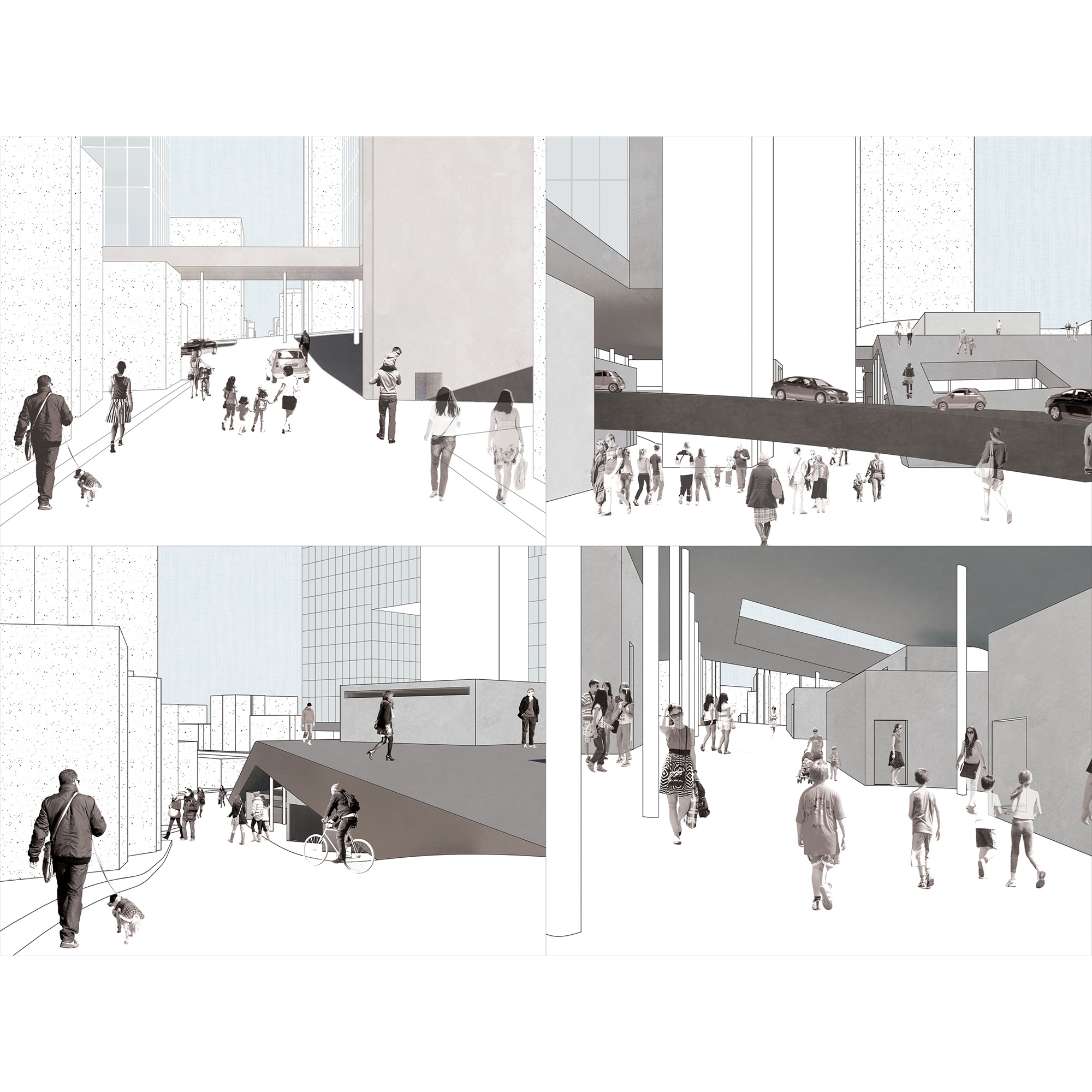이수민
Lee Sumin
걷는 순간은 신체(살)이 도시(돌)을 만나는 가장 최전방의 순간이다. 우리는 일상에서 하루도 빠짐없이 도시를 걸어 다니며, 걷지 않고서 일상이 유지될 수 없다. 그러나 우리는 오로지 걷기 위해 한강으로, 서울숲으로, 즉 일상이 아닌 다른 곳으로 떠난다. 서울에서 걷기는 왜 이벤트가 되었을까? 일상에서 걷기는 이벤트적 걷기와 무엇이 다른가?
이벤트적 걷기는 목적지 없이 과정만을 위한 행위인 반면, 일상에서 걷기는 목적지로 도달하기 위한 이동 수단이다. 특히 일상에서 걷는 순간은 출발지에서 지하철을 타는 순간까지, 다시 교통수단에서 내려서 목적지에 도달하는 순간까지 발생한다. 이때 도시조직 내부에 위치하는 목적지에 도달하기 위해서는 지하철역에서 내려 고층건물들 사이를 지나 목적지로 걸어가게 된다. 즉, 신체는 슈퍼블록 내부를 뚫고 들어가는 순간을 필연적으로 경험하게 된다. 이때 스케일과 시스템이 극단적으로 다른 두 도시조직의 충돌을 신체는 아무런 보호장치 없이 몸소 받아들인다. 특히 폭 12m 대로에 6m 이면도로가 바로 접하는 강남의 블록은 마치 대동맥에 모세혈관이 붙어 있는 것과 같으며, 서울의 8~9km 길이 슈퍼블록은 고층건물들의 집합체인 뉴욕 맨해튼, 한 변 110m의 블록으로 구성된 바르셀로나와 비교해도 굉장히 이례적이다. 그렇다면 적어도 서울에서 걷기에 대한 접근은 달라야 하지 않을까? 일상에서 걷는 순간이 변화할 수 없을까?
슈퍼블록에서 걷기에 대한 질문은 곧 고층건물의 하부가 어때야 하는가에 관한 질문이다. 대표적인 슈퍼블록인 강남역 11번 출구가 위치한 블록, 그 중에서도 강남역 맛의 거리의 끝 신논현역 4,5번 출구에서 걷기의 변화 가능성을 제시한다. 고층건물을 코어만 제외하고 위로 띄우고, 지하철역과 지형을 연결한 후 주변 도시조직을 땅에 점진적으로 스며들게 한다. 이로써 코어와 주변 도시조직이 비슷한 맥락으로 작동하게 된다. 강남 교보문고와 르 메르디앙 서울 호텔, 12차선 대로에 대응함과 동시에 기능을 충족시키는 매스를 위치시키고 도시적 맥락을 고려한 보이드를 뚫는다. 고층건물의 하부를 연장한 판을 삽입하여 도심에서 이벤트적 걷기의 가능성도 제안한다. 또한 판이 불명확한 경계의 공간을 형성함으로써, 누구의 소유권도 아닌, 강남을 걷는 모두에게 열린 공간, 걷다가 쉴 수 있는 공간을 제공한다.
Walking is the moment when flesh meets city face to face. We walk through city every day of our life, and it is impossible to live our life without walking. However, we go Han-river, Seoul forest, and somewhere else that we don’t visit in ordinary life to walk. Why did walking become a special event in Seoul? What is different between nondaily walk and daily walk?
Nondaily walk is an act of walking without any destination, whereas walk in daily life is a mean of transportation to get to somewhere. Especially, the moment we walk is restricted to the moment from starting point until we get on transportation, and again form the moment we get off transportation to the destination. We often walk through the walls high rise buildings to get to the destination inside city organization. In other words, the body inevitably must walk through superblock, the moment in which human scale and non-human scale collides, and cars and people crash.
Especially, in gang-nam, 6m street is linked right into 24m street, which is similar to the situation that a capillary vessel is connected to main artery. Compared to Manhattan or Barcelona, about 9km long super block in Seoul is very exceptional. If so, shouldn’t walking in Seoul be different from any other cities? Is there any other possibilities that daily walk in Seoul can change?










